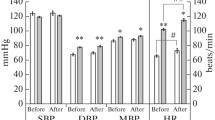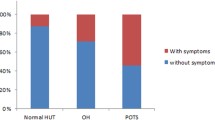Summary
The cardiovascular responses to a 10-min 1.22 rad (70°) head-up tilt orthostatic tolerance test (OST) was observed in eight healthy men following each of a 5-min supine baseline (control), 4 h of 0.1 rad (6°) head-down tilt (HDT), or 4 h 0.52 rad (30°) headup tilt (HUT). An important clinical observation was presyncopal symptoms in six of eight subjects following 4 h HDT, but in no subjects following 4 h HUT. Immediately prior to the OST, there were no differences in heart rate, stroke volume, cardiac output, mean arterial pressure and total peripheral resistance for HDT and HUT. However, stroke volume and cardiac output were greater for the control group. Mean arterial pressure for the control group was less than HDT but not HUT. Over the full 10-min period of OST, the mean arterial pressure was not different between groups. Heart rate increased to the same level for all three treatments. Stroke volume decreased across the full time period for control and HDT, but only at 3 and 9 min for HUT. There was a higher total peripheral resistance in the HDT group than control or HUT. The pre-ejection period to left ventricular ejection time ratio was less in HDT than for control or HUT groups. These data indicate a rapid adaptation of the cardiovascular system to 4 h HDT that appears to be inappropriate on reapplication of a head to foot gravity vector. We speculate that the cause of the impaired orthostatic tolerance is decreased tone in venous capacitance vessels so that venous return is inadequate.
Similar content being viewed by others
References
Bernstein DP (1986) A new stroke volume equation for thoracic electrical bioimpedance: theory and rationale. Crit Care Med 14:904–909
Blamick CA, Goldwater DJ, Convertino VA (1988) Leg vascular responsiveness during acute orthostasis following similated weightlessness. Aviat Space Environ Med 59:40–43
Blomqvist CG, Stone HL (1983) Cardiovascular adjustments to gravitational stress. In: Shepherd JT, Abboud FM, Geiger SR (eds) Handbook of physiology. The Cardiovascular system. Peripheral circulation and organ blood flow. American Physiological Society, Bethesda, MD, pp 1025–1063
Bungo MW, Charles JB, Johnson PC (1985) Cardiovascular deconditioning during space flight and the use of saline as a countermeasure to orthostatic intolerance. Aviat Space Environ Med 56:985–990
Butler GC, Xing HC, Hughson RL (1990) Cardiovascular response to 4 hours of 6° head-down tilt or 30° head-up tilt bed rest. Aviat Space Environ Med 61:240–246
Chobanian AV, Lille RD, Tercyak A, Blevins P (1974) The metabolic and hemodynamic effects of prolonged bed rest in normal subjects. Circulation 49:551–559
Gaffney FA, Nixon JV, Karlsson ES, Campbell W, Dowdey ABC, Blomqvist CG (1985) Cardiovascular deconditioning produced by 20 hours of bedrest with head-down tilt (−5°) in middle-aged healthy men. Am J Cardiol 56:634–638
Greenleaf JE, Sciaraffa D, Shvartz E, Keil LC, Brock PJ (1981) Exercise training hypotension: implications for plasma volume, renin, and vasopressin. J Appl Physiol 51:298–305
Greenleaf JE, Bernauer EM, Ertl AC, Trowbridge TS, Wade CE (1989) Work capacity during 30 days of bed rest with isotonic and isokinetic exercise training. J Appl Physiol 67:1820–1826
Hyatt KH, West DA (1977) Reversal of bedrest-induced orthostatic intolerance by lower body negative pressure and saline. Aviat Space Environ Med 48:120–124
Kubicek WG, Karnegis JM, Patterson RP, Witsoe DA, Mattson RW (1966) Development and evaluation of an impedance cardiac output system. Aerosp Med 37:1208–1212
Levy MN, Talbot JL (1983) Cardiovascular deconditioning of space flight. Physiologist 26:297–303
Lollgen H, Klein KE, Gebhardt U, Beier J, Hordinski J, Sarrasch V, Borger H, Just H (1986) Hemodynamic response to LBNP following 2 hours HDT (−6°). Aviat Space Environ Med 57:406–412
Monos E, Contney SJ, Cowley AW, Stekiel WJ (1989) Effect of long-term tilt on mechanical and electrical properties of rat sphenous vein. Am J Physiol 256:H1185-H1191
Nicogossian AE, Parker JF (1982) Space physiology and medicine. National Aeronautics and Space Administration, Washington, D.C.
Nixon JV, Murray RG, Bryant C, Johnson Jr RL, Mitchell JH, Holland OH, Gomez-Sanchex C, Vergne-Marini P, Blomqvist CG (1979) Early cardiovascular adaptation to simulated zero gravity. J Appl Physiol 46:541–548
Rothe CF (1983) Venous system: physiology of the capacitance vessels. In: Shepherd JT, Abboud FM, Geiger SR (eds) Handbook of physiology. The cardiovascular system III. American Physiological Society, Bethesda, pp 397–452
Stafford RW, Harris WS, Weissler AM (1970) Left ventricular systolic time intervals as indices of postural circulatory stress in man. Circulation 41:485–491
Venitz J, Lucker PW (1984) Impedance cardiography — a reliable method for measuring cardiac function noninvasively. Methods Find Exp Clin Pharmacol 6:339–346
Author information
Authors and Affiliations
Rights and permissions
About this article
Cite this article
Butler, G.C., Xing, H., Northey, D.R. et al. Reduced orthostatic tolerance following 4 h head-down tilt. Europ. J. Appl. Physiol. 62, 26–30 (1991). https://doi.org/10.1007/BF00635629
Accepted:
Issue Date:
DOI: https://doi.org/10.1007/BF00635629




